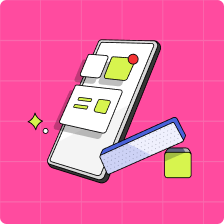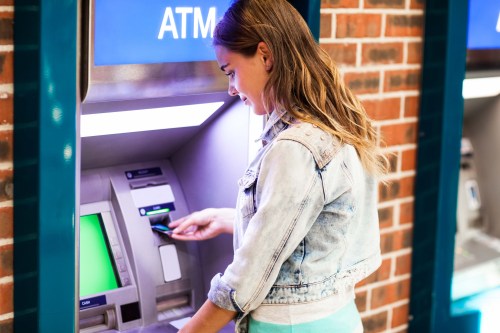As a parent, it’s easy enough to talk to your kids about what they’re doing at school, which shows they’re binge-watching, or what they want for dinner. So why is it so hard to talk about finances?
Let’s be honest: Teaching kids about something like financial literacy can be intimidating, especially if you feel like you’re not a financial whiz yourself. Perhaps you never got much of a financial education growing up, were taught not to flaunt wealth, or grew up with financial insecurity.
And even parents who are comfortable talking about money may not know how to break down seemingly complex financial issues in a way their tweens and teens are going to understand.
But, the thing is, building financial literacy pays off. A 2018 worldwide survey of 15-year-olds found that Canadian teens who talked about finances with their parents—even just once a week—scored 33 points higher in financial literacy than those who did not. This translates to having confidence in planning and tracking spending, which helps teens build a financially secure future.
That’s why we’ve put together this parents’ guide to help you to pass on a solid financial education to your kids. If tweens and teens can grasp basic economic concepts and learn how to use financial tools and access resources, then they’re more likely to be successful at managing their finances as adults. And that’s a win-win for everyone.
What is financial literacy?
In general, financial literacy is learning the basics of how money works in our society, including how to earn, save, and protect it. And helping kids understand what to do with their first earned dollars is one of the first steps in teaching them. From there, kids can start to grasp the concept of savings, how to budget, and eventually how to manage debt. Casual, in-the-moment conversations about all the ways money supports the family, from buying groceries to paying down the mortgage, offer kids real-life examples of decisions they’ll make later in life.
Want to learn more about financial literacy for kids? Read “How to Teach Kids About Money at an Early Age” for tips!
Why is financial literacy important for youth?
Teaching kids about money often starts with a cute preschooler piggy bank. But tweens and teens need guidance to help them navigate the world of personal finance, so they’re more likely to make smart decisions when they’re older. From buying groceries to getting the best internet service provider to saving and investing money, financial literacy makes these everyday money decisions easier to navigate.
Developing solid financial literacy also helps kids become smart shoppers: They learn how to get the best deals for their money, while budgeting for goals and using the resources they have wisely. Advanced financial skills, such as knowing how to tap into government tax credits or investing with a robo-advisor, also help ensure a bright financial future for your burgeoning young adults.
Watching your kids become more self-confident and capable with financial matters will give you the satisfaction of knowing you gave them the leg up they needed. And that’s why it’s smart to make kids comfortable with money talk as soon as possible.
Read more about reasons why financial literacy is important
How do you explain financial literacy to a child?
Teaching kids about financial literacy should start at home with open communication. It doesn’t have to be a structured conversation, either. Use teachable moments that come up every day to talk to your kids about money and finances.
Maybe you see a news item about a company seeking bankruptcy protection—use this to talk about how personal debt might lead to bankruptcy. Or, when you’re tapping your debit or credit card at the gas pump, explain what that means, and that fuel isn’t free. Explain how you made decisions about money that day, and how a budget helps you stay on track and achieve your goals.
Financial education can also be learning on the go. Say your teen calls in a panic because she’s lost her credit card; instead of making accusations or judgments, walk them calmly through the next steps.
You don’t have to pretend you know everything, either. It’s also a valuable lesson for your kids to see you seeking answers, especially if you have your own financial weak spots. And be honest—kids are excellent lie detectors.
If you feel that you could have made better choices, or struggle to balance a budget, share this information using language they will understand. If you can remove anxiety around financial topics, then kids will learn that money is not something they have to avoid talking about. In fact, being open about your own money management will help empower them.

5 key components of financial literacy for Teens
We’ve broken down five key components of financial education for tweens and teens, and how parents can tackle each—one conversation at a time.
1. Earning money
Tweens and teens will more easily grasp the idea of money when it’s up to them to earn their own. Setting up an earnings-based allowance can help them develop an understanding of the value associated with money and what it takes to earn it. And if the thought of becoming your child’s employer and payroll department sounds like yet another massive task on your parenting list, the Mydoh app for parents and kids helps shoulder that responsibility. Designed for kids as young as six-years-old, the app lets you set up chores and pay out a weekly allowance that kids and teens can spend on a Smart Cash Card safely and securely. Mydoh also gives you access to their spending activities and parents can encourage good financial choices with emojis.
Tips for parents
- Financial literacy for teens could mean paying an allowance biweekly, or even monthly. That way, your teens can practise budgeting their money over a longer period of time.
- When your tween or teen has their eye on bigger-ticket items, like concert tickets or a new gaming computer, consider setting up extra or one-off chores around the house (you can easily do this on the Mydoh app!).
- You may choose to stop giving your teens an allowance when they reach a certain age, or when they’re old enough to get a part-time job. From there, you can have conversations about how to read a paycheque, double-checking that the hours they were paid match the hours they worked, plus give your kids an introduction to filing income taxes.
2. Spending cash
Kick-start your kid’s financial education by helping them create a personal budget, which helps give them control over how they spend their money. Balancing a budget will help them track the money coming in and going out, plan for short- and long-term goals, manage monthly expenses, prepare for unexpected surprises, and decrease unnecessary spending or impulse buys.
Tips for parents:
- Make budgeting simpler by taking advantage of tools that help track spending. Have your kids record their spending in a notebook, spreadsheet, or an app that tracks saving and spending, so they know exactly where their money is going. The Mydoh Smart Cash Card lets kids (and parents!) see how much money they have to part with when buying something they want.
- Talk to tweens and teens about buying what they need and discourage impulse shopping by making a list before they head out. Help your kids realize the impact that marketing campaigns and influencers can have on their spending, too.
- Encourage kids to do their research if they’re buying from a company online. Is it a reputable site? Some red flags to look for when shopping online include: unbelievable deals, unclear return policy, the site looks poorly designed or contains no contact information. Remind them to factor shipping costs and sales tax into the budget as well.
- Help kids understand what is free and what costs money (or costs them their personal data or privacy) when playing online games, downloading songs, or streaming movies or TV shows.
3. Saving and investing
The sooner kids learn the concept of saving money, the bigger their financial literacy head start. By the time your child is nine or 10 years old, or even younger, they can understand concepts like needs versus wants. Tweens and teens can also grasp the importance of saving money and planning for short- and long-term goals. Teens can set up a basic personal savings account to get comfortable with everyday banking and learn the concept of earning interest on their money. You may even want to match their savings to support the good habit of saving money.
Tips for parents
- Help your child develop a charitable mindset by encouraging them to set aside money for donations. Start with a conversation about causes they’re interested in and may want to support. This discussion could then lead to learning how receipts from charities registered with the Canada Revenue Agency can be claimed on their income tax return in the future, thereby lowering their taxable income.
- Another simple way to boost financial literacy for teenagers is to open a practice investment portfolio to help them learn about income and growth. The practice investment portfolio is free, but teens will need to be enrolled in RBC online banking to set up their practice account.
Mydoh’s savings goal calculator does the math for you! Teens can calculate how much they earn, spend, and what they can save.
4. Borrowing money
Why do money matters concern teenagers? Debt! You can help your kids stay out of a bad debt cycle by teaching them about borrowing before they get their first credit card.
Emphasize how important it is to pay a credit card bill in full every month to avoid accruing interest charges. Make sure teens understand that making the minimum payment on a credit card bill will cost them—the added interest will make items they buy more expensive than the sticker price. Plus, the longer they take to pay back that debt, the more interest they’ll accumulate, and the harder it will be to pay off the original amount they borrowed.
Teaching kids about borrowing money also includes a conversation on credit reports and credit scores—but this topic shouldn’t be all doom and gloom. Teens can learn that if they manage a credit card well, they can actually boost their credit rating. On the flip side, skipping a credit card payment may seem harmless to a teen, but it can have long-term repercussions. Not paying your bills on time can negatively impact their credit score, meaning it would be harder to get a car loan, rent an apartment, or even get a job (some employers do credit checks as part of the interview process).
Tips for parents
- If you use credit cards openly and wisely, then your child will be more likely to follow your example.
- Reinforce the idea that a credit card isn’t free money. Use a loan repayment calculator to show tweens and teens how much a last-minute, discounted vacation would actually cost them if they only paid the minimum amount each month.
5. Protecting themselves
It’s true that most kids are more tech-savvy than their parents, but tweens and teens may not yet have the experience to deal with identity theft or online scams that target impressionable kids. And that’s not all—not every kid understands the importance of security. “What’s the big deal?” they like to ask. Talk to your kids about online privacy and security, such as password-protecting all their devices, and why it’s important not to share personal information, such as their address, with anyone online.
As a parent, stress to your kids how important it is to look for secure sites before providing payment or identifying information. Kids often have no idea that a fun quiz or personality survey they’re taking online could actually be hackers phishing for information. Teach your kids why it’s important to be vigilant and to check their bank account and credit card statements regularly. If there is a problem, the sooner it’s detected, the less damage to their long-term financial health.
Tips for parents
- Teach kids to never toss old bills or preprinted credit card offers into the trash or recycling bin without shredding them first.
- Browse websites that begin with HTTPS, which are using encryption policies to protect information.
- Look for the green lock symbol in the address bar of websites, especially if kids are buying goods or sharing personal information.
- Be extra cautious when browsing on mobile devices—website addresses are shortened and may not be what you think they are.

How can kids improve financial literacy?
Once you teach your children about money and finances, don’t think you can sit back and rest easy! Like many subjects in life, it’s important to keep talking to them regularly. Kids forget stuff, and if healthy habits aren’t practised and reinforced, they start to lose them. Here are five ways you can help to continually improve your child’s financial literacy as they grow older:
1. Look for everyday opportunities to get kids excited about money matters.
Teach them to get creative and think outside the box: Take a look at family volunteer vacations, where everyone works a little to give back to the local community, instead of an all-inclusive resort. Or teach your fitness-loving teen how to talk to the owner of their favourite (pricey) hot yoga studio to see if they can trade classes for sweat equity. Maybe your tween loves making bracelets; you could have a budding entrepreneur on your hands.
2. Sit down with your kids and discuss what they’re learning in school.
Teens may want to know more about stocks, saving for college or university, or buying their first car. This is a great time to talk about how an RESP is used to save for school tuition, or how a TFSA can help them save for big-ticket items. Remember, the earlier they start saving, the better!
3. Use financial literacy tools, such as calculators and worksheets.
Giving your kids the tools they need to manage their money will help give them a sense of empowerment as they move forward in life. Don’t be afraid to look for outside resources that will help you.
Chartered Professional Accountants Canada have published a book, Raising Money-Smart Kids: How to Teach Your Kids about Money While Learning a Few Things Yourself to help guide parents through the five aspects of money management—earn, save, spend, share, and invest. They also have a financial literacy podcast, Mastering Money.
Giving your kids access to financial literacy tools and resources like the Mydoh money management app can also help reinforce money basics in a fun, interactive environment.
Read more: 10 best finance books for kids and teens.
4. Ensure they’re enrolled in a financial literacy course.
Some provinces and territories, including Ontario, Alberta, and British Columbia, now mandate financial literacy courses in schools. Kids in younger grades can learn about currency and ways to represent different amounts of money. Older students should learn about interest rates, taxes, and balancing budgets.
5. Give them real-world experience
If your teen has a part-time summer job and is trying to figure out their first pay stub and its tax deductions, they’re learning financial skills. You can help them learn where those amounts go if they ask, but don’t be afraid to let them solve their own problems where they can. Kids are more likely to learn best from their own experiences.
How to keep the money conversation going with your kids
Teaching kids about money doesn’t have to be a downer. Use the Mydoh app and Smart Cash Card to help build the foundation of financial literacy for your kids and you’ll be surprised at how much fun it can be. Putting in even a little time to talk to them about money will yield the reward of financial literacy, which will pay off throughout their lives.
Download the Mydoh money management app for parents and kids to get started today.
This article offers general information only and is not intended as legal, financial or other professional advice. A professional advisor should be consulted regarding your specific situation. While the information presented is believed to be factual and current, its accuracy is not guaranteed and it should not be regarded as a complete analysis of the subjects discussed. All expressions of opinion reflect the judgment of the author(s) as of the date of publication and are subject to change. No endorsement of any third parties or their advice, opinions, information, products or services is expressly given or implied by Royal Bank of Canada or its affiliates.






















